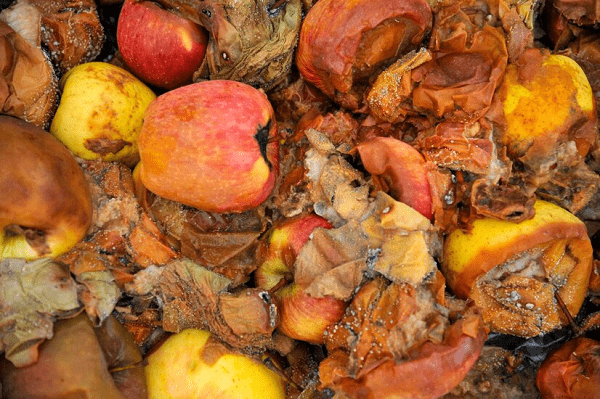Rancidity- Rancidity refers to the development of off-putting and unpleasant flavors and odors in fats, oils, and fatty foods due to the breakdown of their chemical structure. It is a common problem in many food products and can lead to the deterioration of quality, taste, and nutritional value. Rancidity can occur through various processes, and the two primary types are oxidative rancidity and hydrolytic rancidity:
- Oxidative Rancidity:
- Oxidative rancidity is the most common type and occurs when fats and oils are exposed to oxygen in the air. Oxygen molecules react with the double bonds present in unsaturated fatty acids, causing them to become unstable and break down.
- This process generates compounds such as peroxides and aldehydes, which are responsible for the off-flavors and odors associated with rancidity. These compounds can make food products taste and smell “stale” or “rancid.”
- Antioxidants, such as vitamin E and BHA (butylated hydroxyanisole), are often added to food products to slow down the oxidative rancidity process.
- Hydrolytic Rancidity:
- Hydrolytic rancidity occurs when fats and oils break down due to the presence of water (moisture) and enzymes. This process is often seen in foods like nuts, where the natural enzymes present in the nuts can react with the fats.
- Hydrolysis of fats and oils leads to the release of free fatty acids, which can have a sour or soapy taste and contribute to the rancid flavor and odor.
Preventing rancidity is crucial in the food industry to maintain product quality and shelf life. Some common methods to prevent rancidity include:
- Proper Storage: Store fats and oils in airtight containers to minimize exposure to oxygen and moisture.
- Refrigeration: Refrigeration can slow down the oxidation process, extending the shelf life of many fatty foods.
- Packaging: Using oxygen-barrier packaging materials can help protect fats and oils from exposure to air.
- Antioxidants: Adding synthetic or natural antioxidants to food products can inhibit oxidative rancidity.
- Hydrogenation: Partial hydrogenation of oils can increase their stability, although this process can also create trans fats, which are less healthy.
- Dehydration: Reducing moisture content in foods can help prevent hydrolytic rancidity.
Rancidity is a significant concern in the food industry and has implications for both food quality and safety. Consumers can also take steps to prevent rancidity by storing and handling fats and oils properly to ensure that their favorite foods remain fresh and flavorful.
What is Rancidity
Rancidity is a term used to describe the development of unpleasant and stale flavors and odors in various food products, particularly those containing fats and oils. It occurs when the fats and oils in these foods undergo chemical changes, leading to the degradation of their taste, aroma, and overall quality. Rancidity is a common problem in many foods and can occur through various mechanisms:
- Oxidative Rancidity: This is the most common type of rancidity and occurs when fats and oils react with oxygen in the air. This reaction causes the fats and oils to become oxidized, resulting in the formation of compounds that give off undesirable flavors and odors. These compounds can make the food taste and smell “off” or “rancid.”
- Hydrolytic Rancidity: Hydrolytic rancidity occurs when fats and oils break down due to the presence of water (moisture) and enzymes. This process can lead to the release of free fatty acids, which can have a sour or soapy taste and contribute to the rancid flavor and odor.
Rancidity can affect a wide range of food products, including cooking oils, nuts, seeds, snack foods, baked goods, and even certain dairy products. Factors that can contribute to the development of rancidity include exposure to air (oxygen), light, heat, moisture, and the presence of catalysts such as enzymes.
To prevent rancidity, food manufacturers often use antioxidants to slow down oxidative rancidity and take measures to reduce moisture and oxygen exposure in their products. Consumers can also help prevent rancidity by storing food properly, in airtight containers, away from heat and light, and by following recommended storage guidelines for specific products. Proper handling and storage can help maintain the quality and flavor of food and extend its shelf life.
Who is Required Rancidity
“Required Rancidity” is not a recognized term or concept. It’s possible that you’re looking for information related to rancidity in a specific context or industry, but without additional information, it’s challenging to provide a specific answer.
If you have a more specific question or if you meant to inquire about something related to rancidity in a particular field or context, please provide more details, and I’ll do my best to assist you.
“Rancidity” is not a person or an individual; rather, it is a term used to describe a chemical process that affects fats and oils in food, causing them to develop unpleasant flavors and odors due to their degradation. Rancidity is not associated with any particular person or entity; it is a concept related to food science and chemistry. If you have a different question or need information on a specific topic, please provide more details, and I’ll be happy to assist you further.
When is Required Rancidity

Rancidity can occur in food products containing fats and oils when specific conditions or factors are present. It is not a matter of “when” in the sense of a specific time, but rather a result of various factors. Here are some situations and conditions that can lead to rancidity:
- Exposure to Oxygen: Oxygen is a primary catalyst for oxidative rancidity. When fats and oils are exposed to oxygen in the air, they can undergo chemical reactions that lead to the development of rancid flavors and odors. This can happen over time as the food product is exposed to air.
- Exposure to Light: Some fats and oils are sensitive to light, particularly ultraviolet (UV) light. Exposure to light can accelerate the oxidation process and promote rancidity in certain food products.
- High Temperatures: Elevated temperatures, such as those found in frying or cooking, can accelerate the oxidation of fats and oils, leading to rancidity. Storing food products in warm or hot conditions can also contribute to rancidity over time.
- Moisture: Water (moisture) can lead to hydrolytic rancidity. When moisture is present in foods containing fats and oils, it can break down the chemical bonds in fats through hydrolysis, releasing free fatty acids and contributing to a rancid taste and odor.
- Presence of Catalysts: Enzymes and certain trace metals can act as catalysts, speeding up the chemical reactions that lead to rancidity. Enzymes, for example, can be naturally present in some foods, and their activity can be influenced by factors like temperature and pH.
To prevent rancidity, food manufacturers and consumers take steps to minimize these conditions. This includes proper storage in airtight containers, keeping products away from light and heat, using antioxidants, and following recommended storage guidelines for specific foods.
Where is Required Rancidity
Rancidity can occur in various food products that contain fats and oils. It’s not a physical location but a chemical process that can happen under certain conditions. Here are some examples of where rancidity can occur:
- Cooking Oils: Rancidity can develop in cooking oils when they are exposed to air, heat, and light over time. This often happens in the kitchen when oils are stored improperly or used for frying at high temperatures.
- Nuts and Seeds: Nuts and seeds contain natural oils that can become rancid if not stored in a cool, dry place and protected from exposure to oxygen.
- Processed Foods: Rancidity can affect a wide range of processed foods that contain fats and oils, including packaged snacks, baked goods, and convenience foods.
- Salad Dressings and Sauces: Salad dressings and sauces that contain oils can become rancid if they are not properly sealed and stored in the refrigerator.
- Animal Fat: Rancidity can develop in animal fats used for cooking or in processed meat products that contain fats.
- Dairy Products: Some dairy products with a high fat content, like butter and certain cheeses, can develop rancidity if exposed to air and not stored correctly.
- Grains: Grains and flours that contain small amounts of oil, such as whole grains or whole wheat flour, can become rancid over time if not stored properly.
In all of these cases, rancidity is a chemical process that occurs when fats and oils within the food product break down due to exposure to oxygen, heat, light, or other factors. It leads to the development of off-flavors and odors, making the food unpalatable and potentially less nutritious. To prevent rancidity, proper storage and handling of food products containing fats and oils are essential.
How is Required Rancidity
Rancidity is a chemical process that occurs in fats, oils, and foods containing fats and oils when certain conditions are present. It involves the breakdown of the fats and oils, leading to the development of unpleasant flavors and odors. Rancidity can occur through different mechanisms, primarily oxidative rancidity and hydrolytic rancidity. Here’s how these processes work:
- Oxidative Rancidity: This is the most common type of rancidity and occurs when fats and oils react with oxygen in the air. Here’s how it happens:
- Oxygen molecules react with the double bonds present in unsaturated fatty acids, causing them to become unstable.
- This leads to the formation of peroxides and other compounds that are responsible for the off-flavors and odors associated with rancidity.
- These compounds can make the food taste and smell “stale” or “rancid.”
- Hydrolytic Rancidity: Hydrolytic rancidity occurs when fats and oils break down due to the presence of water (moisture) and enzymes. Here’s how it works:
- Water molecules can break the chemical bonds in fats through hydrolysis, releasing free fatty acids.
- These free fatty acids can have a sour or soapy taste and contribute to the rancid flavor and odor.
Rancidity can affect a wide range of food products, including cooking oils, nuts, seeds, snack foods, baked goods, and dairy products. Proper storage, handling, and the use of antioxidants are common strategies to prevent rancidity and extend the shelf life of these products.
Case Study on Rancidity
Rancidity in Packaged Potato Chips
Background: A popular snack food company produces and distributes a range of potato chip products with various flavors. These potato chips are known for their quality, taste, and long shelf life. However, the company recently received several customer complaints about the chips having an unusual and unpleasant flavor.
Problem: Customers reported that the potato chips had an off-flavor and odor that resembled rancidity. The company decided to investigate the issue to maintain its reputation and customer satisfaction.
Investigation: The company initiated an investigation into the reported problem of rancid-tasting potato chips. Here’s how they approached the case:
- Product Sampling: The company collected samples of the affected potato chip products from different batches and production dates.
- Laboratory Analysis: The collected samples were sent to a food testing laboratory for analysis. The laboratory conducted tests to determine the chemical composition of the chips, specifically looking for signs of rancidity.
- Results: The laboratory analysis confirmed the presence of rancidity in the potato chips. Oxidative rancidity was identified as the primary cause. High levels of peroxides and free fatty acids were found, which contributed to the off-flavor and odor.
- Root Cause Analysis: The company conducted a thorough review of its production and storage processes. They discovered that the packaging process had experienced occasional issues, leading to small openings in some chip bags. This allowed air to enter and come into contact with the potato chips, promoting oxidative rancidity.
Solutions: The company implemented several solutions to address the issue of rancidity in their potato chips:
- Improved Packaging: The packaging process was revised to ensure airtight seals on all chip bags, minimizing exposure to oxygen.
- Quality Control: Enhanced quality control measures were implemented to detect any potential packaging defects before products left the production facility.
- Storage Guidelines: The company provided clear storage guidelines for retailers and consumers, recommending that potato chips be stored in a cool, dry place away from direct sunlight.
- Antioxidants: The company also evaluated the use of antioxidants in the chip seasoning to further extend the shelf life and delay oxidative rancidity.
Outcome: Following these changes, the company saw a significant reduction in customer complaints about rancid-tasting potato chips. The product’s quality and shelf life improved, and customers returned to enjoying their favorite snack without experiencing the unpleasant flavors and odors associated with rancidity.
This case study highlights the importance of quality control, proper packaging, and understanding the causes of rancidity in the food industry to maintain product quality and customer satisfaction.
White paper on Rancidity
Title: Understanding Rancidity in Food Products: Causes, Effects, and Solutions
Abstract: Provide a concise summary of the white paper’s key points and findings.
Table of Contents:
- Introduction
- Define rancidity and its significance in the food industry.
- State the purpose and scope of the white paper.
- Types of Rancidity
- Discuss oxidative rancidity.
- Discuss hydrolytic rancidity.
- Explain the differences between the two types.
- Chemical Reactions in Rancidity
- Detail the chemical reactions responsible for rancidity.
- Describe the formation of peroxides, aldehydes, and free fatty acids.
- Factors Influencing Rancidity
- Oxygen exposure and its role.
- Temperature effects on rancidity.
- The impact of light and moisture.
- The role of enzymes and catalysts.
- Rancidity in Specific Food Products
- Discuss rancidity in cooking oils.
- Explore rancidity in nuts and seeds.
- Examine rancidity in packaged snacks and baked goods.
- Address rancidity in dairy products.
- Detection and Measurement
- Methods for detecting rancidity in food products.
- Common analytical techniques.
- Sensory evaluation and consumer perception.
- Preventing and Managing Rancidity
- Antioxidants and their role.
- Proper storage and handling guidelines.
- Packaging solutions to minimize oxygen exposure.
- Quality control measures.
- Case Studies
- Present real-world examples of rancidity issues and their resolutions.
- Regulatory Considerations
- Discuss food safety regulations related to rancidity.
- Labeling requirements and consumer information.
- Future Trends and Research
- Explore emerging technologies and research areas related to rancidity prevention.
- Highlight potential innovations in food preservation.
- Conclusion
- Summarize the key takeaways from the white paper.
- Emphasize the importance of understanding and addressing rancidity in the food industry.
- References
- Cite academic papers, research studies, and authoritative sources used in the white paper.
This outline provides a structured framework for a white paper on rancidity in food products. You can expand on each section with detailed information, data, case studies, and references to create a comprehensive document that educates readers about the causes, effects, and solutions related to rancidity in the food industry.





